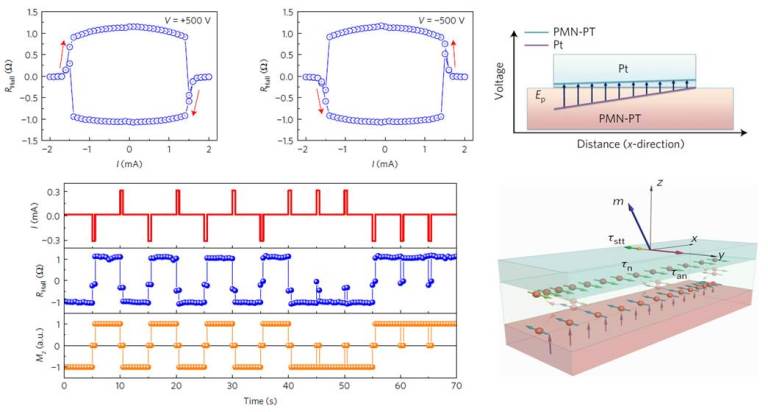Recently, a research team led by Prof. WANG Kaiyou, at the State Key Laboratory of Superlattices and Microstructures, Institute of Semiconductors, Chinese Academy of Sciences, demonstrated their work on all-electric and programmable manipulations of ferromagnetic bits without external magnetic field in a hybrid ferromagnetic/ferroelectric structure.
Over the past decade, extensive studies have been carried out to utilize spintronic devices for memory, logic applications. In recent years, spin-orbit torque is considered as an effective way to control the magnetization. The spin torque is generated by spin current due to the spin Hall effect. While an external magnetic field along the current direction is always needed to realize the deterministic switching, which will hinder the practical application. A lateral wedge oxide, titled magnetic easy axis, and anti-ferromagnetic layer has been reported to induce a deterministic switching. However, switching based on the structural asymmetry is not controllable once the devices were fabricated. Controllable and reliable means to manipulate the magnetization all-electrically by spin-orbit torque are highly demanded.
The work by Prof. Wang’s group experimentally verified a controllable deterministic switching by fabricating Hall devices on ferroelectric PMN-PT substrate. Depending on the polarization direction of the PMN-PT substrate, which acts on the spins in the bottom Pt layer by spin-orbit coupling, the clockwise or anti-clockwise switching loops of magnetization were observed without external magnetic field. A continuous and stable switching of the magnetization was demonstrated by applying a series of current pulses, which could be used as a magnetic random access memory.
Furthermore, they provided theoretic explanations based on micromagentic simulation. The polarization of ferroelectric substrate leads to a perpendicular electric field along the interface of bottom Pt and PMN-PT, which will induce a gradient of spin current density at the interface between Pt and CoNiCo layer. They introduced an extra torque due to the gradient of spin density and analyzed the effect on the magnetization, the theoretic results are consistent with the experimental observations. This torque is also suitable for other non-equilibrium systems with spatial distribution of spin current, which offers us an essential insight of deterministic switching.
This work entitled with ‘Electric field control of deterministic current-induced magnetization switching in a hybrid ferromagnetic/ferroelectric structure’ (DOI: 10.1038/nmat4886) has been published in Nature Materials on April 3rd, 2017.
This work was supported by NSFC grand of China, ‘973 Program’ and K.C. Wong Education Foundation. PhD student CAI Kaiming and Assistant Prof. YANG Meiyin are the co-first authors. Prof. WANG Kaiyou is the corresponding author. They collaborated with Prof. LI Baohe in Beijing Technology and Business University, Dr. WANG Sumei in Institute of Microelectronics, CAS, Dr. Kevin William Edmonds in University of Nottingham, Prof. JI Yang and ZHENG Houzhi in Institute of Semiconductors.

Fig. 1. Electrical controllable deterministic switching by current without external magnetic field. The gradient of perpendicular electric field is formed at the interface between of Pt and PMN-PT substrate. The additional torque due to the gradient of spin current density is illustrated, which leads to a deterministic switching. (Image by Prof. WANG Kaiyou)
Contact:
Prof. WANG Kaiyou
E-mail: kywang@semi.ac.cn
Institute of Semiconductors, CAS (http://english.semi.cas.cn/)
